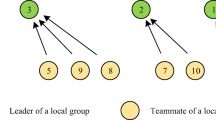Abstract
The bare bones particle swarm optimization algorithm is wildly used in different areas. However, this algorithm may suffer from premature convergence by getting trapped in a local optimum when dealing with multimodal functions. To solve this problem, a dynamic allocation bare bones particle swarm optimization (DABBPSO) algorithm is proposed in this work. Particles are divided into two groups before evaluation according to their personal best position. One group is named as main group (MG) and the other one is called the ancillary group (AG). The MG focuses on digging and trying to find the optimal point in the current local optimum. Conversely, the AG aims at exploring the research area and giving the whole swarm more chances to escape from the local optimum. The two groups work together to find the global optimal in the search area. Also, the DABBPSO is applied to a set of well-designed experiments and a set of 0–1 knapsack problems. Finally, the experimental results confirm the optimization ability of the proposed algorithm.




Similar content being viewed by others
References
Kennedy J (2003) Bare bones particle swarms. In: Proceedings of the 2003 IEEE swarm intelligence symposium. (SIS2003), pp 80–87
Kennedy J, Eberhart R (1995) Particle swarm optimization. In: Proceedings of IEEE international conference on Neural Networks (ICNN1995), vol 4, pp 1942–1948
Mendes R, Kennedy J, Neves J (2004) The fully informed particle swarm: simpler, maybe better. IEEE Trans Evol Comput 8(3):204–210
Kennedy J, Mendes R (2006) Neighborhood topology in fully-informed and best-of-neighborhood particle swarms. IEEE Trans Syst Man Cybern Part C (Applications and Reviews) 36(4):515–519
Liang JJ, Qin AK, Suganthan PN, Baskar S (2006) Comprehensive learning particle swarm optimizer for global optimization of multimodal functions. IEEE Trans Evol Comput 10(3):281295
Zhan Z-H, Zhang J, Li Y, Chung HS-H (2009) Adaptive particle swarm optimization. IEEE Trans Syst Man Cybern Part B Cybern Publ IEEE Syst Man Cybern Soc 39(6):1362–1381
Li J, Zhang J, Jiang C, Zhou M (2015) Composite particle swarm optimizer with historical memory for function optimization. IEEE Trans Cybern 45(10):2350–2363
Zhan ZH, Zhang J, Li Y, Shi YH (2011) Orthogonal learning particle swarm optimization. IEEE Trans Evol Comput 15(6):832–847
Blackwell T (2012) A study of collapse in bare bones particle swarm optimization. IEEE Trans Evol Comput 16(3):354–372
Campos M, Krohling RA, Enriquez I (2014) Bare bones particle swarm optimization with scale matrix adaptation. IEEE Trans Cybern 44(9):1567–1578
Yang S, Sato Y (2016) Modified bare bones particle swarm optimization with differential evolution for large scale problem. In: 2016 IEEE congress on evolutionary computation (CEC2016), pp 2760–2767
Guo J, Sato Y, Pair-wise A (2017) Bare bones particle swarm optimization algorithm. In: 2017 IEEE/ACIS 16th international conference on computer and information science (ICIS2017), no. 1, pp 353–358
Guo J, Sato Y (2017) A bare bones particle swarm optimization algorithm with dynamic local search. In: Tan Y, Takagi H, Shi Y (eds) Advances in swarm intelligence. ICSI 2017. Lecture notes in computer science, vol 10385. Springer, Cham
Author information
Authors and Affiliations
Corresponding author
About this article
Cite this article
Guo, J., Sato, Y. A dynamic allocation bare bones particle swarm optimization algorithm and its application. Artif Life Robotics 23, 353–358 (2018). https://doi.org/10.1007/s10015-018-0440-3
Received:
Accepted:
Published:
Issue Date:
DOI: https://doi.org/10.1007/s10015-018-0440-3




